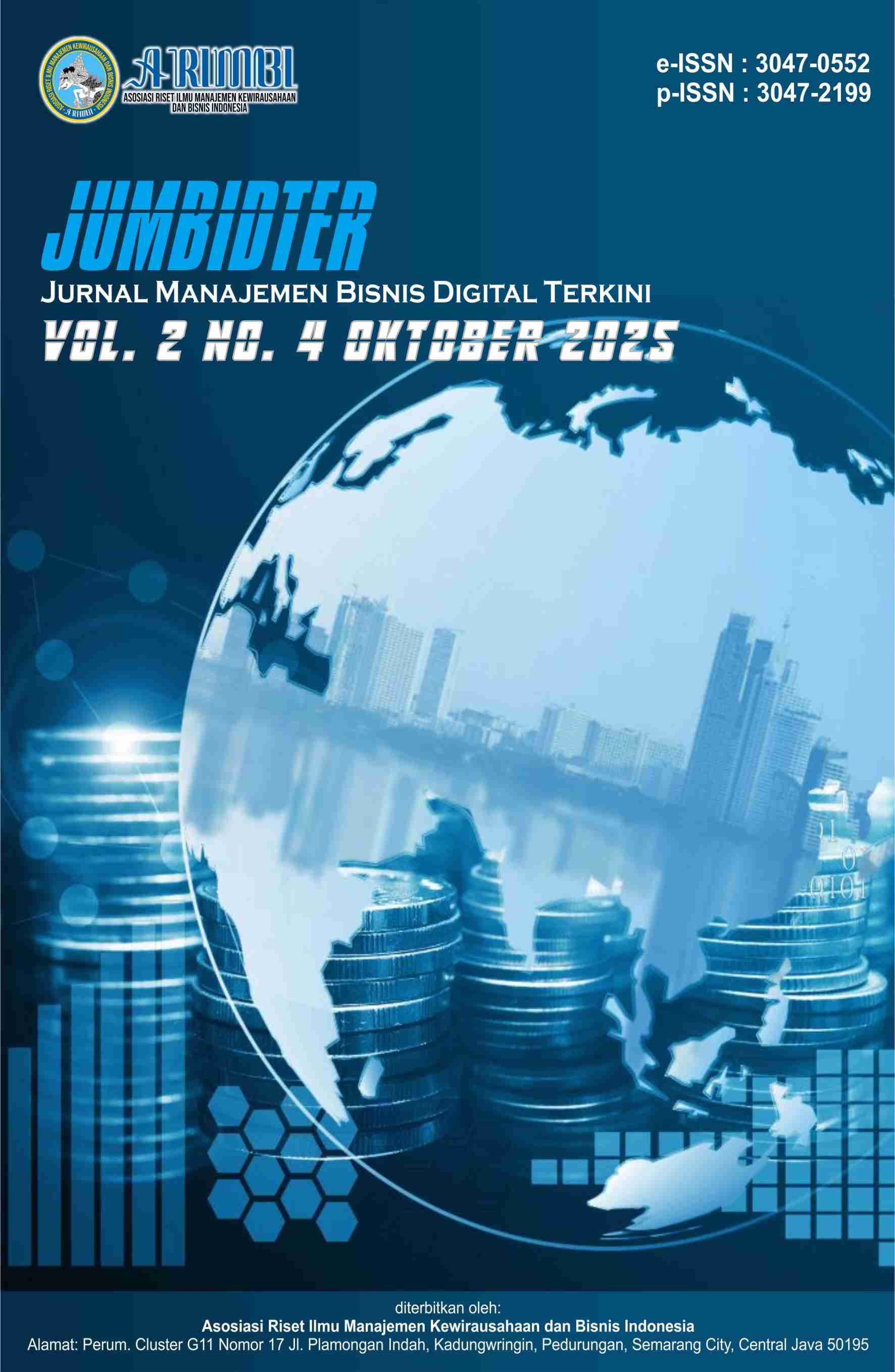Pengaruh Rasio Likuiditas dan Rasio Solvabilitas terhadap Rasio Profitabilitas pada Perusahaan Sub Sektor Otomotif dan Komponen yang Terdaftar di Bursa Efek Indonesia Periode 2019-2023
DOI:
https://doi.org/10.61132/jumbidter.v2i4.819Keywords:
Automotive industry, Current Ratio, IDX, Profitability, Solvency ratioAbstract
Along with economic recovery and fiscal stimulus, the automotive industry is starting to show a recovery trend. The purpose of this study was to determine the effect of liquidity ratios and solvency ratios on profitability in automotive sub-sector companies and components listed on the Indonesia Stock Exchange for the 2019- 2023 period. The method used in this research is quantitative with a descriptive approach using secondary data in the form of financial reports of companies listed on the Indonesian stock exchange for the 2019-2023 period. The data collection technique used in this study is the documentation technique, namely by collecting secondary data in the form of the company's annual financial statements obtained from the official website of the Indonesian stock exchange and the official website of each company. The results of the study based on partial tests show that Current Ratio has no significant effect on ROA with a t value < t table, namely 0.255 < 2.02439 and a significant value of 0.800> 0.05 and partially Debt to Equity Ratio has a negative and significant effect on ROA with a t value < t table, namely -2.336 < 2.02439 and a significant value of 0.25 < 0.05. Meanwhile, based on the simultaneous test, Current Ratio and Debt to Equity Ratio simultaneously have a positive and significant effect on the Return On Asset (ROA) variable with the value of t count> t table, namely 3.518> 3.25 and a significant value of 0.040 <0.05.
Downloads
References
Antara News. (2023). Menperin: Indonesia jadi pusat otomotif yang sibuk di ASEAN.
Ballinda, E., Lau, E. A., & Suharyono, E. Y. (2023). Sustainable profitability with assets management analysis: A case study of PT Tri Ananda Pratama Balikpapan - Indonesia. Indonesian Journal of Sustainability Policy and Technology, 1(1), 17–29. https://doi.org/10.61656/ijospat.v1i1.117
Brigham, E. F., & Houston, J. F. (2018). Dasar-dasar manajemen keuangan (Edisi ke-14). Salemba Empat.
Daniar Paramita, R. W., Rizal, N., & Sulistyan, R. B. (2021). Metode penelitian kuantitatif. Widya Gama.
Firdaus, E., & Fuadati, S. R. (2020). Pengaruh profitabilitas, leverage dan likuiditas terhadap nilai perusahaan pada perusahaan ritel yang terdaftar di BEI.
GAIKINDO. (2021). Wabah, resesi ekonomi, dan turunnya penjualan mobil 48 persen pada 2020. GAIKINDO. https://www.gaikindo.or.id/wabah-resesi-ekonomi-dan-turunnya-penjualan-mobil-48-persen-pada-2020/
GAIKINDO. (2022). Sepanjang 2021 penjualan mobil domestik di atas 800 ribu unit. GAIKINDO.
Hafids Ramadana, D., Siska, E., & Indra, N. (2023). Pengaruh perputaran modal kerja dan likuiditas terhadap profitabilitas perusahaan makanan dan minuman yang terdaftar di Bursa Efek Indonesia. Jurnal Manajemen Riset Inovasi, 1(3), 146–159. https://doi.org/10.55606/mri.v1i3.1293
Kasmir. (2019). Analisis laporan keuangan. Rajawali Pers.
Mar’aqonitatillah, A., & Setiyono, W. P. (2024). Likuiditas, profitabilitas dan leverage berpengaruh signifikan terhadap nilai perusahaan di sektor farmasi Indonesia. Sciences and Clinical Pharmacy Research Journal, 1(2), 16. https://doi.org/10.47134/scpr.v1i2.2513
metrocom jaddi technology. (n.d.). Industri otomotif Indonesia menuju era kendaraan listrik, sudah siapkah?
Nainggolan, E. P., & Febriasyah, A. R. (2021). Pengaruh rasio profitabilitas dan biaya.
Novitasari, D. P., & Viriany. (2019). Pengaruh profitabilitas, ukuran perusahaan dan likuiditas terhadap kebijakan hutang perusahaan manufaktur. Jurnal Pajak Akuntansi, 1(2), 153–162. https://doi.org/10.24912/jpa.v1i2.4676
Nurmasita, S., Siska, E., & Indra, N. (2023). Pengaruh profitabilitas dan likuiditas terhadap kebijakan hutang pada perusahaan manufaktur yang terdaftar di Bursa Efek Indonesia tahun 2019–2022. Jurnal Manajemen Riset Inovasi, 1(3), 160–173. https://doi.org/10.55606/mri.v1i3.1294
Qosim, N., Latoki, L., Studi Manajemen, P., & Ekonomi, F. (2024). Pengaruh return on asset (ROA), return on equity (ROE), return on investment (ROI), dan earning per share (EPS) terhadap nilai perusahaan pada industri otomotif dan komponennya yang tercatat di BEI.
Rahmania Shafira. (2022). Pengaruh return on asset, current ratio, dan debt to equity ratio terhadap nilai perusahaan (pada perusahaan manufaktur sub sektor perusahaan otomotif yang terdaftar di Bursa Efek Indonesia periode 2014–2020) [Skripsi, Universitas Medan Area].
Rompas, I. M. L., & Rumokoy, L. J. (2023). Pengaruh current ratio, debt to equity ratio, dan total asset turnover terhadap return on asset perusahaan sub sektor otomotif & komponen di Bursa Efek Indonesia periode 2015–2021. Jurnal EMBA, 11(1), 833–843. https://doi.org/10.35794/emba.v11i1.46377
Santini Arik, N. K., & Baskara Kajeng, I. G. (2018). Pengaruh perputaran modal kerja, ukuran perusahaan dan likuiditas terhadap profitabilitas perusahaan tekstil dan garmen. E-Jurnal Manajemen Universitas Udayana, 7(12), 6790–6815. https://doi.org/10.24843/EJMUNUD.2018.v07.i12.p05
Solihin, D. (2019). Pengaruh current ratio dan debt to equity ratio terhadap return on asset (ROA) pada PT Kalbe Farma, Tbk. Jurnal Kajian, 7(1), 115–122. https://doi.org/10.32493/jk.v7i1.y2019.p115-122
Suherman, A., & Siska, E. (2021). Manajemen keuangan (W. Jati & A. Ariyanto, Eds.). Insan Cendekia Mandiri.
Downloads
Published
Issue
Section
License
Copyright (c) 2025 Jurnal Manajemen Bisnis Digital Terkini

This work is licensed under a Creative Commons Attribution-ShareAlike 4.0 International License.





